Drones are revolutionizing the way we approach reforestation. With the ability to plant up to 100,000 seeds per day, these drones are making a significant impact in areas damaged by deforestation.
The use of tree planting drones is a game-changer in environmental conservation. By leveraging environmental conservation technology, we can restore forests and promote biodiversity.
This innovative approach not only accelerates the reforestation process but also helps in areas that are difficult to reach.
Key Takeaways
- Drones can plant up to 100,000 seeds per day.
- Tree planting drones are revolutionizing reforestation efforts.
- Environmental conservation technology is being leveraged to restore forests.
- Drones can reach areas that are difficult to access.
- The use of drones in reforestation promotes biodiversity.
The Global Deforestation Crisis
Earth’s forests are in peril due to rampant deforestation, necessitating immediate attention and action. Forests cover about 30% of the Earth’s land, providing habitat for a vast array of species, influencing climate patterns, and supporting local communities.
Current State of Earth's Forests
The current state of the world’s forests is alarming. According to recent data, millions of hectares of forest are lost each year. This not only results in biodiversity loss but also exacerbates climate change. As Dr. Thomas Crowther, a renowned environmental scientist, notes, “Forests are crucial for carbon sequestration and are a key component in the fight against climate change.”
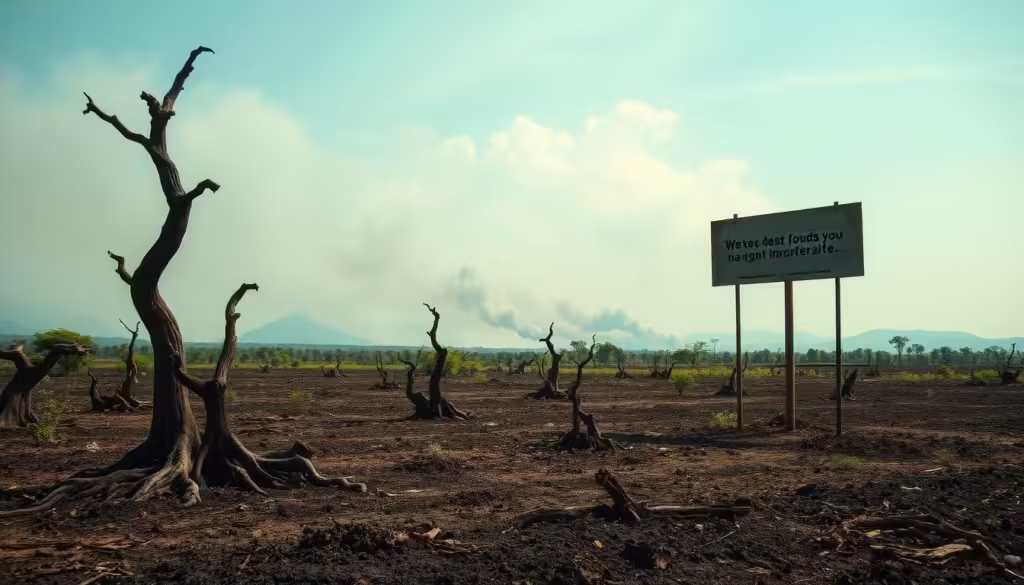
Primary Causes of Deforestation
Deforestation is primarily driven by agricultural expansion, urbanization, and logging activities. The increasing demand for soy, palm oil, and cattle products has led to widespread forest clearance.
“The main driver of deforestation is the global demand for commodities,” states the World Wildlife Fund.
Addressing these drivers is crucial to halting deforestation.
Ecological and Climate Consequences
The consequences of deforestation are far-reaching. Forests play a vital role in regulating the climate, and their loss contributes to global warming. Moreover, forests support complex ecosystems; their destruction leads to loss of biodiversity and ecosystem disruption. It’s imperative to adopt sustainable practices and reforestation efforts to mitigate these impacts.
In conclusion, the global deforestation crisis demands urgent attention. Understanding its causes and consequences is the first step towards finding effective solutions. Through concerted efforts in sustainability and reforestation, we can work towards preserving Earth’s forests for future generations.
Traditional Reforestation Methods and Their Limitations
For years, traditional reforestation methods have been employed to restore damaged forests, but they have significant limitations. Reforestation methods have evolved over time, but manual planting remains the most common technique.
Manual Planting Techniques
Manual planting involves physically planting seeds or seedlings in the ground. This method is labor-intensive and relies heavily on human effort. While it allows for some selectivity in terms of species and placement, it’s not efficient for large-scale reforestation efforts.
Challenges in Difficult Terrain
One of the significant challenges faced by traditional reforestation methods is operating in difficult terrain. Areas with steep slopes, dense undergrowth, or remote locations make manual planting hazardous and logistically complicated. The terrain itself can limit access to certain areas, hindering the reforestation process.
Labor and Time Constraints
Labor and time constraints are significant limitations of traditional reforestation methods. Manual planting is time-consuming and requires a large workforce. The process can be slow, and the cost of labor can be high, making it challenging to achieve large-scale reforestation goals in a timely manner.
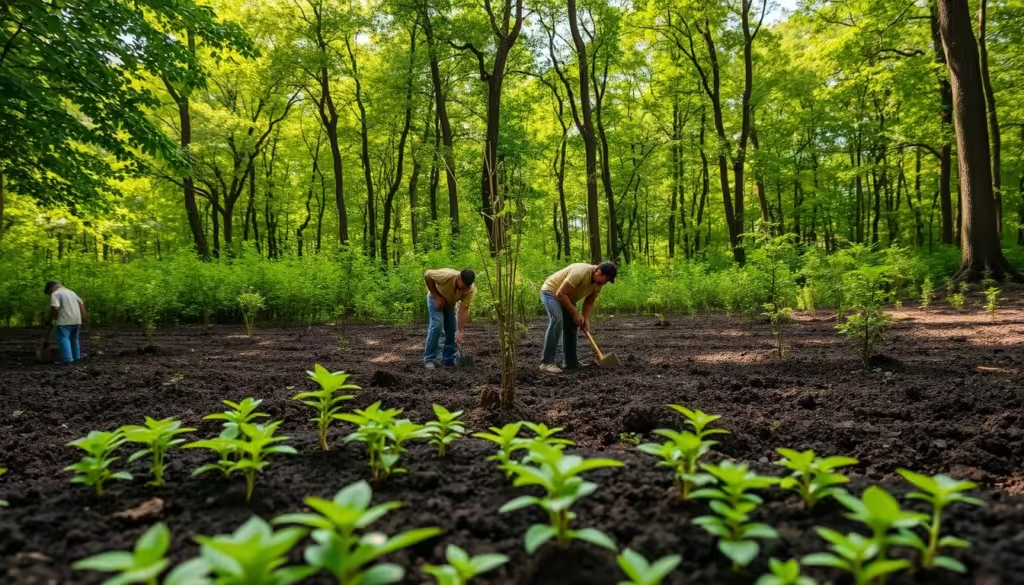
The limitations of traditional reforestation methods highlight the need for more efficient and effective solutions. As we explore in the following sections, technology, particularly drone technology, is playing a crucial role in addressing these challenges.
The Revolution of Drone Technology in Environmental Conservation
In recent years, drones have transformed from mere recreational gadgets to powerful tools for ecological restoration. This shift is largely due to advancements in drone technology that have enabled their use in a variety of environmental conservation efforts.
Evolution of Commercial Drone Applications
Initially, drones were used in industries such as filmmaking, construction, and agriculture. However, their application has expanded significantly over the years. Today, drones are utilized in surveying, mapping, and monitoring environmental changes. Companies like DJI have been at the forefront of this technological advancement, providing drones that are not only capable of capturing high-resolution imagery but also equipped with sensors for monitoring environmental parameters.
Adaptation for Environmental Purposes
The adaptation of drones for environmental purposes has been a game-changer. Drones equipped with specialized payloads, such as seed pods or sensors, can now be used for reforestation and monitoring forest health. For instance, BioCarbon Engineering is using drones to plant trees in areas damaged by deforestation, significantly increasing the efficiency of reforestation efforts.
Key Technological Breakthroughs
Several technological breakthroughs have facilitated the use of drones in environmental conservation. These include advancements in AI-powered mapping systems, which enable precise targeting of areas for reforestation or conservation. Additionally, improvements in battery technology have extended the operational range of drones, allowing them to cover larger areas.

“The use of drones in reforestation efforts has the potential to revolutionize the way we approach ecological restoration.”
The integration of drone technology in environmental conservation represents a significant step forward in sustainability efforts. As the technology continues to evolve, we can expect to see even more innovative applications in the field.
How Tree-Planting Drones Actually Work
Reforestation efforts have taken a significant leap forward with the introduction of tree-planting drones that use AI and biodegradable seed pods. These drones are designed to restore damaged ecosystems efficiently by planting seeds in areas that are difficult to reach through traditional reforestation methods.
Seed Pod Design and Biodegradable Materials
The seed pods used by tree-planting drones are designed to provide optimal conditions for germination. Made from biodegradable materials, these pods protect the seeds during flight and after planting, increasing the chances of successful germination. The materials used are carefully selected to ensure they don’t harm the environment.
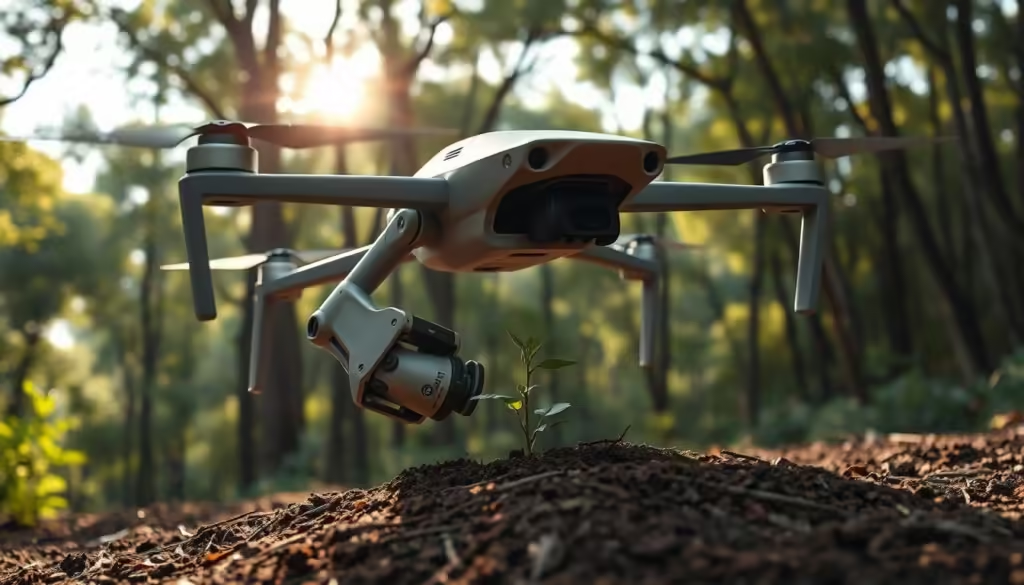
AI-Powered Mapping and Targeting Systems
Tree-planting drones utilize AI-powered mapping to identify areas that need reforestation. This technology allows the drones to create detailed maps of the terrain, pinpointing the most suitable locations for planting seeds. The AI system ensures that the seeds are distributed evenly and in the right conditions for growth.
Deployment Mechanisms
The deployment mechanisms of tree-planting drones involve sophisticated systems for releasing seed pods. This includes:
- Precision dropping techniques that ensure seeds are planted in the most suitable locations.
- Germination enhancement technology that gives seeds the best possible start in life.
Precision Dropping Techniques
The precision dropping techniques employed by tree-planting drones allow for accurate placement of seeds. This is crucial in ensuring that the seeds have the best chance of germinating and growing into healthy trees.
Germination Enhancement Technology
Germination enhancement technology is integrated into the seed pods to improve the survival rate of the seeds. This technology can include coatings that retain moisture and provide nutrients, giving the seeds a strong start.
By combining advanced technology with ecological expertise, tree-planting drones are revolutionizing the way we approach reforestation. As this technology continues to evolve, we can expect to see even more efficient and effective reforestation efforts.
Impressive Capabilities: Planting100,000 Seeds Per Day
Drones are revolutionizing reforestation efforts by planting up to 100,000 seeds per day. This significant advancement in Green Tech is transforming the way we approach environmental conservation.
Speed Comparison with Human Planters
Traditional tree planting methods rely heavily on manual labor, which can be time-consuming and costly. In contrast, drones can cover vast areas quickly, planting seeds at a rate that far surpasses human capabilities. For instance, a single drone operator can manage multiple drones simultaneously, increasing the overall efficiency of the planting process.
A study comparing drone planting to manual planting found that drones could plant seeds up to 10 times faster than human planters.
Coverage Area and Efficiency Metrics
Drones are not only fast but also highly efficient in terms of coverage area. They can be programmed to cover specific zones, ensuring that seeds are planted in the most effective pattern. The efficiency metrics of drone planting include:
- Area covered per hour
- Seeds planted per minute
- Accuracy of seed placement
| Method | Area Covered (hectares/hour) | Seeds Planted (per minute) |
|---|---|---|
| Drone Planting | 10 | 1000 |
| Manual Planting | 1 | 100 |
Survival Rates of Drone-Planted Seeds
One of the critical factors in reforestation is the survival rate of planted seeds. Drones are equipped with technology that ensures seeds are planted in optimal conditions, enhancing their chances of survival. According to a report by DroneSeed, a company specializing in drone reforestation, the survival rates of drone-planted seeds are comparable to, if not better than, those planted manually.
“The use of drones in reforestation not only increases the speed and efficiency of planting but also improves the survival rates of seeds due to precise placement and optimal soil conditions.” –
Cost-Effectiveness Analysis
While the initial investment in drone technology can be substantial, the long-term cost-effectiveness is significant. Drones reduce labor costs, minimize the need for heavy machinery, and can operate in challenging terrains where traditional methods might fail.
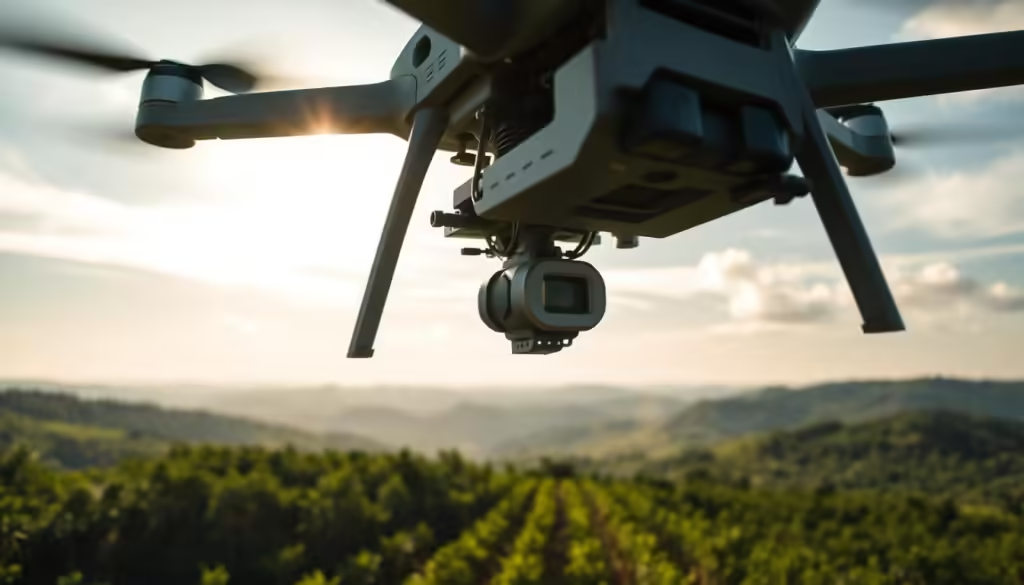
As the technology continues to evolve, we can expect to see even more efficient and cost-effective solutions for reforestation efforts.
Leading Green Tech Companies Pioneering Drone Reforestation
Green Tech companies are at the forefront of using drones for reforestation, bringing new hope to damaged ecosystems. This innovative approach is not only efficient but also cost-effective, making it an attractive solution for large-scale reforestation projects.
DroneSeed's Post-Wildfire Restoration Approach
DroneSeed is a company that has made significant strides in post-wildfire restoration. Their drone technology allows for the rapid deployment of seeds in areas that are difficult to access. This approach has shown promising results in restoring ecosystems damaged by wildfires.
Flash Forest's Diverse Species Planting Strategy
Flash Forest is another company making waves in the drone reforestation space. They focus on planting a diverse range of species, which is crucial for maintaining healthy ecosystems. Their strategy involves using drones to plant seeds in a variety of environments, from urban areas to remote wilderness.
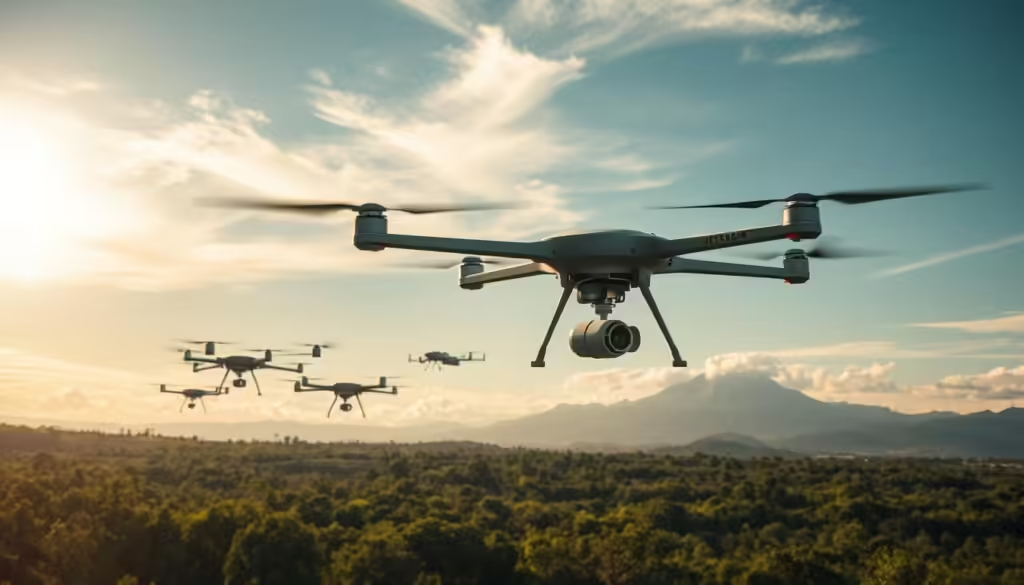
BioCarbon Engineering's Global Scaling Model
BioCarbon Engineering is a UK-based company that has developed a drone-based reforestation system. Their technology is designed to be scalable, with the potential to restore millions of hectares of forest globally. They are working on projects in various countries, demonstrating the global applicability of their model.
Startups Driving Innovation in the Field
Several startups are also driving innovation in drone reforestation. These companies are developing new technologies and approaches that are improving the efficiency and effectiveness of reforestation efforts. Their work is crucial in pushing the boundaries of what is possible in environmental conservation.
The collective efforts of these Green Tech companies are making a significant impact on the environment. By leveraging drone technology, they are not only restoring forests but also contributing to a more sustainable future.
- DroneSeed is pioneering post-wildfire restoration.
- Flash Forest is planting diverse species.
- BioCarbon Engineering is scaling their model globally.
- Startups are driving innovation in the field.
Success Stories: Drone Reforestation Transforming Damaged Ecosystems
Drone technology is being harnessed to restore ecosystems, with several success stories emerging from around the world. The use of drones in reforestation efforts has shown remarkable results, transforming damaged ecosystems into thriving forests.
North American Forest Recovery Projects
In North America, drone reforestation has been instrumental in restoring forests damaged by wildfires. For instance, companies like DroneSeed have been using drones to plant seeds in areas affected by wildfires, achieving a higher survival rate compared to traditional methods.
Initiatives in Developing Nations
In developing nations, drone reforestation initiatives have not only helped in restoring forests but also provided economic opportunities for local communities. For example, BioCarbon Engineering has been working in countries like Uganda and Kenya, using drones to plant trees and restore degraded landscapes.
Measuring Long-Term Impact and Forest Health
Measuring the long-term impact of drone reforestation is crucial. Studies have shown that areas reforested using drones have improved forest health, with increased biodiversity and better carbon sequestration. As BioCarbon Engineering notes, “Our drone reforestation efforts have shown a significant increase in forest density and health.”
According to a recent report, “The use of drones in reforestation has the potential to revolutionize the way we restore forests, offering a cost-effective and efficient solution to deforestation.”
“Drones are not just a tool, they’re a game-changer in reforestation. They allow us to reach remote areas and plant seeds with precision, increasing the chances of survival.”
The success stories from drone reforestation projects highlight the potential of this technology in transforming damaged ecosystems and combating climate change.
Climate Change, Environment, and Sustainability Benefits
The use of drones in reforestation efforts is revolutionizing our approach to combating climate change. By leveraging this technology, we can address multiple aspects of environmental sustainability simultaneously.
Carbon Sequestration Potential
Trees play a crucial role in absorbing carbon dioxide from the atmosphere, and drone-based reforestation can significantly enhance this natural process. By planting trees in areas that have been deforested or degraded, we can increase the global carbon sequestration potential, helping to mitigate the effects of climate change.
Biodiversity Restoration Effects
Drones enable the planting of a diverse range of tree species, which is crucial for restoring ecosystems. This biodiversity is essential for maintaining healthy forests that can support a wide variety of plant and animal life, enhancing ecological resilience.
Watershed Protection and Soil Stabilization
Forests help protect watersheds by maintaining soil quality and preventing erosion. Drone-planted trees can stabilize soil, reduce the risk of landslides, and ensure that water sources remain clean and reliable.
Economic Benefits for Local Communities
Reforestation efforts, facilitated by drones, can also provide economic benefits to local communities. By creating jobs and promoting sustainable forest management, these initiatives can contribute to local economies while fostering environmental stewardship.
In conclusion, the integration of drones in reforestation efforts offers a multifaceted approach to addressing climate change and promoting environmental sustainability. By enhancing carbon sequestration, restoring biodiversity, protecting watersheds, and supporting local economies, drone-based reforestation is a powerful tool in our fight against environmental degradation.
Challenges and Limitations in Drone Reforestation Technology
While drone reforestation technology has shown promising results, it is not without its challenges. As this innovative approach continues to evolve, several limitations have come to the forefront.
Technical Obstacles in Various Environments
One of the primary challenges faced by drone reforestation is navigating diverse terrains and weather conditions. Drones must be capable of operating in rugged landscapes, high winds, and varying temperatures, which can significantly impact their efficiency and effectiveness.
| Environmental Factor | Impact on Drones | Potential Solutions |
|---|---|---|
| High Winds | Reduced stability and accuracy | Advanced stabilization systems |
| Rugged Terrain | Difficulty in navigation and landing | Improved GPS and terrain-following technology |
| Extreme Temperatures | Battery performance issues | Thermal management systems |
Species Selection and Ecological Considerations
Selecting the right species for reforestation is crucial for ecological balance. Drones must be programmed to plant species that are suitable for the local ecosystem, taking into account factors such as soil type, climate, and biodiversity.
Regulatory Hurdles and Airspace Restrictions
Drone reforestation faces significant regulatory challenges, including airspace restrictions and the need for permits. Navigating these legal requirements can be complex and time-consuming, potentially hindering the progress of reforestation efforts.
Monitoring and Maintenance Challenges
After planting, monitoring the success of drone-reforested areas is essential. This involves tracking seedling survival rates, growth, and overall forest health, which can be resource-intensive and require additional technological solutions.
In conclusion, while drone reforestation technology holds great promise, addressing these challenges is crucial for its long-term success. By understanding and overcoming these limitations, we can further enhance the effectiveness of this innovative approach to environmental conservation.
The Future of Earth's Forests: Combining Technology and Nature
As we look to the future, the synergy between technology and nature is poised to revolutionize the way we restore and preserve Earth’s forests. “The future of reforestation is not just about planting trees, it’s about leveraging technology to create sustainable ecosystems,” says a leading expert in environmental conservation.
Next-Generation Drone Capabilities
The next generation of drones is expected to have enhanced capabilities, including improved AI-powered mapping systems and more efficient seed pod designs. These advancements will enable drones to plant seeds with even greater precision and speed.
Integration with Other Conservation Technologies
The integration of drones with other conservation technologies, such as satellite imaging and sensor networks, will provide a more comprehensive approach to forest restoration. This holistic approach will enable conservationists to monitor forest health more effectively and respond to threats in real-time.
Scaling from Regional Projects to Global Solutions
As the technology continues to evolve, we can expect to see a scaling up of drone reforestation projects from regional initiatives to global solutions. This will involve collaboration between governments, NGOs, and private companies to restore forests on a massive scale.
Research and Development Frontiers
Research and development in this field are ongoing, with scientists exploring new biodegradable materials for seed pods and more efficient drone designs. The future of Earth’s forests looks promising, with technology playing a crucial role in their restoration and preservation.
By combining technology and nature, we can create a more sustainable future for our planet. As BioCarbon Engineering and other Green Tech companies continue to innovate, the potential for large-scale forest restoration becomes increasingly achievable.
Conclusion: Drones as Powerful Allies in Combating Deforestation
Drones have emerged as a groundbreaking solution in the fight against deforestation, revolutionizing environmental conservation efforts. By leveraging advanced technology, these aerial devices are capable of planting up to 100,000 seeds per day, significantly accelerating reforestation processes.
The integration of drones in combating deforestation not only enhances the efficiency of tree planting but also contributes to sustainability by promoting ecological balance. Companies like DroneSeed and Flash Forest are at the forefront of this innovation, utilizing AI-powered mapping and biodegradable seed pods to restore damaged ecosystems.
As technology continues to evolve, the potential for drones to make a lasting impact on environmental conservation grows. By combining drone technology with other conservation efforts, we can create a more sustainable future and mitigate the effects of climate change. The role of drones in reforestation efforts is a testament to human ingenuity in addressing environmental challenges.
FAQ
What is drone reforestation?
Drone reforestation is the use of drones to plant trees and restore forests, especially in areas damaged by deforestation. Companies like DroneSeed and Flash Forest are pioneering this technology.
How do tree-planting drones work?
Tree-planting drones use AI-powered mapping and targeting systems to identify areas for reforestation. They then deploy seed pods made from biodegradable materials, often with germination enhancement technology to improve seed survival rates.
What are the benefits of using drones for reforestation?
Drones can plant up to 100,000 seeds per day, making them much faster than human planters. They also improve seed survival rates and can access difficult terrain, making them a cost-effective solution for large-scale reforestation efforts.
Are drone-planted seeds as effective as those planted by humans?
Studies have shown that drone-planted seeds can have high survival rates, comparable to or even exceeding those planted by humans, thanks to the precision and technology used in drone reforestation.
What are the challenges facing drone reforestation technology?
Technical obstacles in various environments, species selection, regulatory hurdles, and monitoring and maintenance challenges are some of the key limitations. However, ongoing research and development are addressing these issues.
Can drone reforestation help combat climate change?
Yes, by restoring forests, drone reforestation can help sequester carbon, restore biodiversity, protect watersheds, and stabilize soil, all of which contribute to mitigating the effects of climate change.
How can I get involved in drone reforestation efforts?
You can support companies like DroneSeed, Flash Forest, and BioCarbon Engineering, or look into local initiatives that may be using drone technology for reforestation. Donating to or volunteering with these organizations can also make a difference.
What is the future of drone reforestation?
The future looks promising, with advancements in drone technology, integration with other conservation technologies, and scaling up from regional to global solutions. Ongoing research and development are expected to further enhance the effectiveness of drone reforestation.




